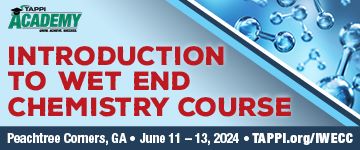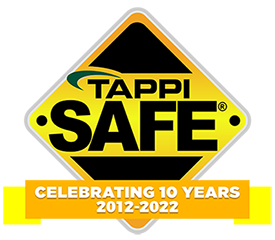 Search
Search
Use the search bar or filters below to find any TAPPI product or publication.
Filters
Content Type
Publications
Level of Knowledge
Committees
Collections
Magazine articles

Evolution and development of headbox systems for specialty nonwoven formers, TAPPI JOURNAL, February 1992, Vol. 75(2)
Evolution and development of headbox systems for specialty nonwoven formers, TAPPI JOURNAL, February 1992, Vol. 75(2)
Magazine articles

Behavioral observation: gathering data for continuous safety improvement, TAPPI JOURNAL, February 1992, Vol. 75(2)
Behavioral observation: gathering data for continuous safety improvement, TAPPI JOURNAL, February 1992, Vol. 75(2)
Magazine articles

Papermakers conference draws more than 900 attendees, TAPPI JOURNAL, July 1993, Vol. 76(7)
Papermakers conference draws more than 900 attendees, TAPPI JOURNAL, July 1993, Vol. 76(7)
Magazine articles

Capital cost analysis looks at recent and future trends, TAPPI JOURNAL, November 1992, Vol. 75(11)
Capital cost analysis looks at recent and future trends, TAPPI JOURNAL, November 1992, Vol. 75(11)
Magazine articles

Controlling anaerobic bacteria to improve product quality and mill safety, TAPPI JOURNAL, February 1991, Vol. 74(2)
Controlling anaerobic bacteria to improve product quality and mill safety, TAPPI JOURNAL, February 1991, Vol. 74(2)
Magazine articles

1994 polymers, laminations and coatings conference highlights technology basics, TAPPI JOURNAL, December 1994, Vol. 77(12)
1994 polymers, laminations and coatings conference highlights technology basics, TAPPI JOURNAL, December 1994, Vol. 77(12)
Journal articles

Magazine articles

Extension of a steady-state chlorine dioxide brightening model for Z-ECF bleaching of softwood kraft pulps, TAPPI Journal March 2021
ABSTRACT: Earlier studies developed a steady-state model to predict the brightness and/or bleach consumption during the chlorine dioxide brightening (D1) of softwood pulps produced by conventional elemental-chlorine-free (ECF) sequences. This model relates the chlorine dioxide consumed to the brightness gains predicated upon an asymptotic D1 brightness limit, an incoming D1 pulp brightness, and an equation parameter (ß11). The current investigation examines the application of this model to ECF sequences that use ozone delignification (Z-ECF). Literature D1 data from various Z-ECF bleaching studies, which investigated OZ, OD0/Z, and OZ/D0 delignification, were fitted to the model. The ß11 parameter was found to be linearly correlated to the entering kappa number. Interestingly, this linear relationship was found to be identical to the relationships observed when modeling the D1 stage for conventional ECF and chlorine-based bleach sequences. Subtle differences in D1 brightening response in the model among the various bleach sequences are reflected by incoming pulp brightness (at the same kappa number). The current model is used to illustrate how alterations to Z-ECF delignification affect D1 brightening and chlorine dioxide consumption.
Journal articles

Magazine articles

Use of fines-enriched chemical pulp to increase CTMP strength, TAPPI Journal April 2021
ABSTRACT: In this study, fines-enriched pulp (FE-pulp)—the fine fraction of highly-refined kraft pulp—was benchmarked against highly-refined kraft pulp (HRK-pulp) as a strength agent in eucalyptus chemithermomechanical pulp (CTMP). Both the FE-pulp and the HRK-pulp were produced from unbleached softwood kraft pulp, and equal amounts of those strength agents were added to the original CTMP, as well as to washed CTMP, where most of the fines had been removed. The effects of the added strength agents were evaluated with laboratory handsheets.The FE-pulp proved to be twice as effective as HRK-pulp. Both HRK-pulp and FE-pulp increased the strength of the CTMP handsheets. The bulk of the handsheets decreased, however, as well as the drainability. The addition of 5% FE-pulp resulted in the same strength increase as an addition of 10% HRK-pulp, as well as the same decrease in bulk and CSF. For the handsheets of washed CTMP, the strengths were not measurable; the CTMP lost the sheet strength when the CTMP-fines content was reduced through washing. The reduced strength properties were compensated for by the addition of chemical pulp fines that proved to be an efficient strength agent. The addition of 5% FE-pulp restored the strength values, and at a higher bulk and higher drainability.
Journal articles

Magazine articles

Incorporation of post-consumer pizza boxes in the recovered fiber stream: Impacts of grease on finished product quality, TAPPI Journal March 2021
ABSTRACT: Grease and cheese contamination of used pizza boxes has led to misunderstanding and controversy about the recyclability of pizza boxes. Some collection facilities accept pizza boxes while others do not. The purpose of this study is to determine whether typical grease or cheese contamination levels associated with pizza boxes impact finished product quality. Grease (from vegetable oil) and cheese are essentially hydrophobic and in sufficiently high concentration could interfere with interfiber bonding, resulting in paper strength loss.Findings from this study will be used to determine the viability of recycling pizza boxes at current and future con-centrations in old corrugated containers (OCC) recovered fiber streams. These findings will also be used to inform the acceptability of pizza boxes in the recycle stream and educate consumers about acceptable levels of grease or cheese residue found on these recycled boxes.
Journal articles

Magazine articles

Assessing variation in package modeling, TAPPI Journal April 2021
ABSTRACT: Predictions from empirical models are affected by variability in the input parameters for the data set used to build the models. For corrugated boxes, the difference between actual and modeled compression strength creates a real cost associated with box production, often resulting in boxes that may need to be over-designed to compensate for a lack of model precision. No work to date has attempted to assess the limitation in these compression estimates due to input parameter testing variability. In this paper we approach that problem, initially for the McKee equation and then conceptually for other box models. For our industry to do a better job at meeting the needs of our corrugated packaging customers, we need to reduce the variation in the tests we all rely on, particularly for evaluating material strength (edge crush test [ECT]) and package compression performance (box compression test [BCT]).






